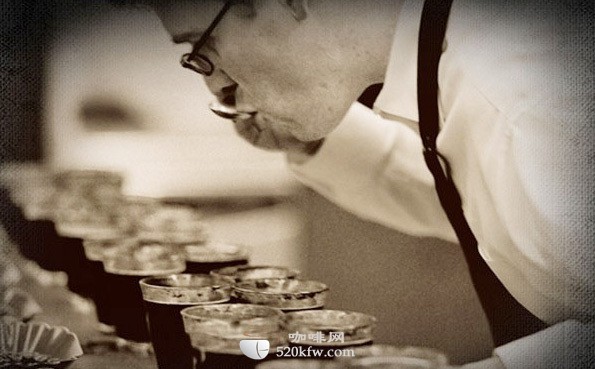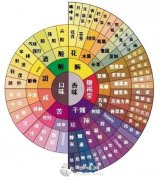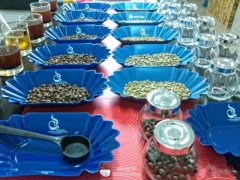Six Steps to Coffee Cup Evaluation
There are six steps in coffee cup evaluation, describing the aroma, aroma, taste, smell, aftertaste and mellowness of coffee.
Picture: ab3a6c70gw1e5uo4ma2xzj20gj0a9gnf.jpg

1. Fragrance: the first step in cup evaluation is to evaluate the aroma of coffee beans. Grind 10 grams of coffee, put it in 3-5 sample cups, and then breathe hard at the gas released by the freshly crushed coffee cells. The characteristics of the aroma indicate the essence of the taste of coffee beans: the sweet smell indicates that its taste is sour; the pungent smell indicates that its taste is irritating. The strength of the aroma indicates the freshness of the coffee, that is, the time it takes from roasting to grinding into powder. The aroma consists of the most volatile aromatic compounds, especially those containing sulfur, such as methyl mercaptan. At present, there is little people can do about how to keep these substances in coffee beans.
two。 Aroma: the second step in cup review is to check the aroma of coffee water. First, pour 150ml of boiled fresh (oxidized) water into the freshly ground coffee powder and let the coffee powder soak in water for 3-5 minutes. Coffee powder forms a cap-shaped shell on top of the water. Stir the coffee with a coffee spoon and break the cap shell. At this time, the caffeine hot water will release the gas into the nasal cavity, so that the nasal diaphragm feel a comprehensive flavor: from fruit, grass, to nutty. The experience of cup review will cause cup reviewers to classify coffee according to the memory of various coffee smells. In the future, different kinds of coffee can be distinguished according to different odors. Generally speaking, the aroma characteristics of coffee are related to the origin of coffee. Correspondingly, the strength of the aroma is related to the freshness of coffee. Freshness is measured by the length of time from baking to cooking. Freshness is also affected by the type of packaging that protects coffee from dampness and non-oxidation.
3. Taste (Taste): carefully savoring the taste of freshly brewed coffee is the third step in cup review coffee. Use a special coffee spoon, usually a round spoon with a capacity of 8 ~ 10cc. Preferably silver-plated, which can dissipate heat quickly. Take out 6 ~ 8cc of coffee water and put it in front of your mouth and sip it hard. Quickly inhale coffee and distribute it evenly on the surface of the tongue. All sensory nerve terminals respond to sweet, salty, sour and bitter tastes at the same time. Because temperature affects the degree of stimulation, paying attention to responses in different sensitive areas of the tongue can help capture different characteristics. For example, because temperature reduces sensitivity to the sweetness of sugar, acidic coffee initially produces a tingling on the tip of the tongue rather than sweetness. Hold the coffee in your mouth for 3-5 seconds and focus on the type and intensity of the taste. In this way, primary and secondary flavor characteristics can be evaluated.
4. Nose: the fourth step is the same as the third step. Inhale coffee through the surface of the tongue. Due to the change of water vapor pressure, part of the organic matter in the water changes from liquid to gaseous state. The act of sucking coffee hard causes the gas to enter the nasal cavity, allowing cup reviewers to analyze the smell of coffee. At the same time, evaluate the taste and smell of coffee, so that cup reviewers feel the unique flavor characteristics of coffee. Standard roasted coffee usually has the taste of caramelized products, while deep-roasted coffee usually has the taste of dry distillation products.
5. Aftertaste (Aftertaste): the fifth step is to put coffee water in your mouth for a few seconds, then swallow a small part. Quickly suck the throat to send the water vapor left in the back palate into the nasal cavity, you can find the smell of the heavier molecules left in the back palate. The aromas of various compounds felt in the aftertaste are sweet, similar to chocolate; or bonfire smoke, or cigar smoke; sometimes, there are similar irritating spices, such as cloves; sometimes, like resin, similar to turpentine; sometimes, there are all these smells. 6. Body: the final stage of cup review is to evaluate the taste of coffee water. The tongue slips gently across the palate of the mouth to feel the texture of the coffee. For oily quality and smooth range
The feeling of degree can measure the fat content in coffee water, while the "heavy", thick and sticky feeling of coffee can measure the fiber and protein content of coffee. The two make up the mellowness of coffee.
Important Notice :
前街咖啡 FrontStreet Coffee has moved to new addredd:
FrontStreet Coffee Address: 315,Donghua East Road,GuangZhou
Tel:020 38364473
- Prev

The relationship between coffee taste and extraction conditions
Coffee is the art of pursuing balance, the extraction law of coffee taste from sour to bitter: 1, shallow roasting (acid) to deep roasting (bitter) 2, rough grinding (sour) to fine grinding (bitter) 3, coffee powder less (acid) to more (bitter) 4, water temperature low (acid) to high water temperature (bitter) 5, extraction speed fast (acid) to slow (bitter) 6, more extraction (acid) to less extraction (bitter).
- Next

Basic knowledge about coffee tasting
Here, I do some common sense popularization. Very often, you will hear a lot of coffee lovers who don't know anything, so they can go to the store and yell, boss, do you have Kopi Luwak? It's Kopi Luwak I drink every day. There are also some coffee lovers with deep expectations for their own coffee. It is trumpeted that Yunnan coffee is comparable to Blue Mountain. These are all quite arbitrary and crude.
Related
- What documents do you need to go through to open a coffee shop? coffee shop coffee shop certificate processing process
- How to purchase Coffee beans in small Cafe how to choose a suitable supplier for domestic Coffee supply Company
- How to drink Starbucks Fragrance White Coffee? how to make Australian White Coffee? what Italian coffee beans are recommended?
- The Story of Flora Coffee: the name of Flora Coffee Bean and the implication of the Flowers on Florna Coffee
- How much does a cup of coffee cost? How much is the profit of a cup of coffee? What is the profit of the coffee shop in a year?
- Yunnan small Coffee, known as "fragrant Coffee", introduces the characteristics of Alpine Arabica Coffee producing areas in Yunnan, China
- 2023 latest Starbucks full menu price list how much is a cup of Starbucks coffee what is better to drink the most popular hot and cold drinks recommended
- Starbucks different kinds of Coffee Price list Starbucks menu 2023 Top Ten Best drinks in Starbucks
- Starbucks Spring praise Comprehensive matching Coffee Bean theme Story Packaging implication and taste description
- The cost of a cup of coffee latte American coffee cost price and selling price

